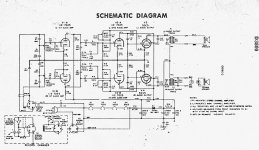It's a crude correction for the rise in high frequency that occurs as the impedance of the speaker rises with frequency. Output impedance is high due to lack of negative feedback. (OK, there IS a little in the bass control section) Also provides some protection against overvoltage from transients and clipping (inductive kick if tube is cut off).
HOWEVER, this circuit is non isolated from the power line. You should add an isolation transformer if you intend to use it with anything but the original changer.
HOWEVER, this circuit is non isolated from the power line. You should add an isolation transformer if you intend to use it with anything but the original changer.
The current production Sovtek 12AX7LPS has a spiral wound (hum bucking) heater, which makes it a genuine 7025 replacement. 😉 The variant has good sonics too. 🙂
Replace the ticking toxic time bomb Selenium rectifier with a 15 cent UF4007. R31 does more than drop a few Volts. It is a peak surge limiter. In the OEM configuration, without an isolation trafo, the B+ supply is connected directly to the AC mains. If the peak surge limiter is absent, the rectifier "fries". I made that mistake over 50 years ago with a Sakes Tarzian M500 Silicon rectifier. FWIW, a CL90 inrush current limiting thermistor along with a tweaked value for R31 that deals with the lower forward drop in Silicon vs. Selenium gets my nod. Increasing the 1st filter cap. to 220 μF. will reduce hum.
Replace the ticking toxic time bomb Selenium rectifier with a 15 cent UF4007. R31 does more than drop a few Volts. It is a peak surge limiter. In the OEM configuration, without an isolation trafo, the B+ supply is connected directly to the AC mains. If the peak surge limiter is absent, the rectifier "fries". I made that mistake over 50 years ago with a Sakes Tarzian M500 Silicon rectifier. FWIW, a CL90 inrush current limiting thermistor along with a tweaked value for R31 that deals with the lower forward drop in Silicon vs. Selenium gets my nod. Increasing the 1st filter cap. to 220 μF. will reduce hum.
It is likely that the electrolytics in this unit will need to be replaced. The originals are rated for 150 volts. That was OK when the line voltage was 110 volts and the selenium rectifier was lossy. Todays line voltage can be as high as 125 volts, so put in 200 volt caps to prevent fireworks.
Todays line voltage can be as high as 125 volts, so put in 200 volt caps to prevent fireworks.
Right on! Space will not be a problem. Capacitance per unit volume has gone WAY up over time. Today's 'lytics bury the old time stuff.
- Status
- Not open for further replies.
